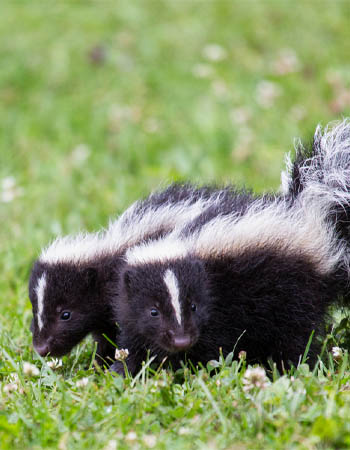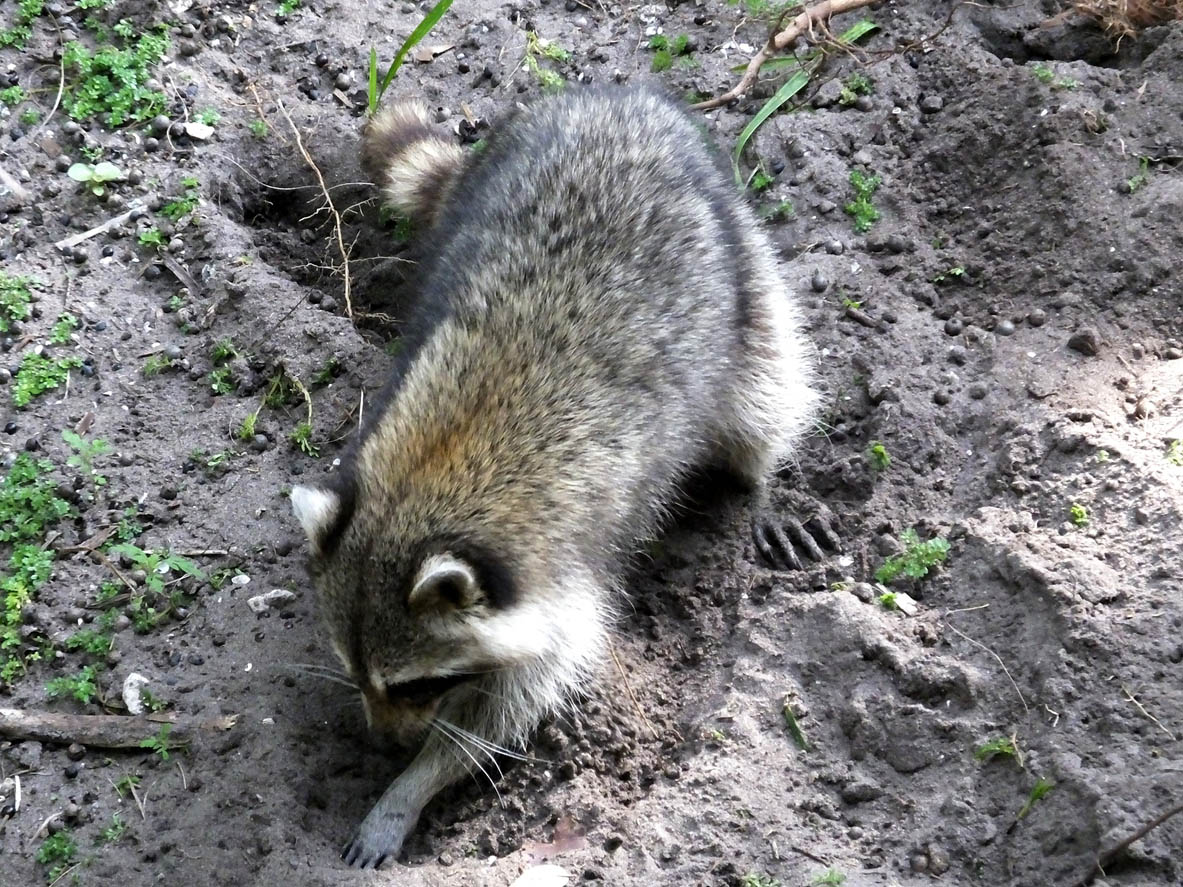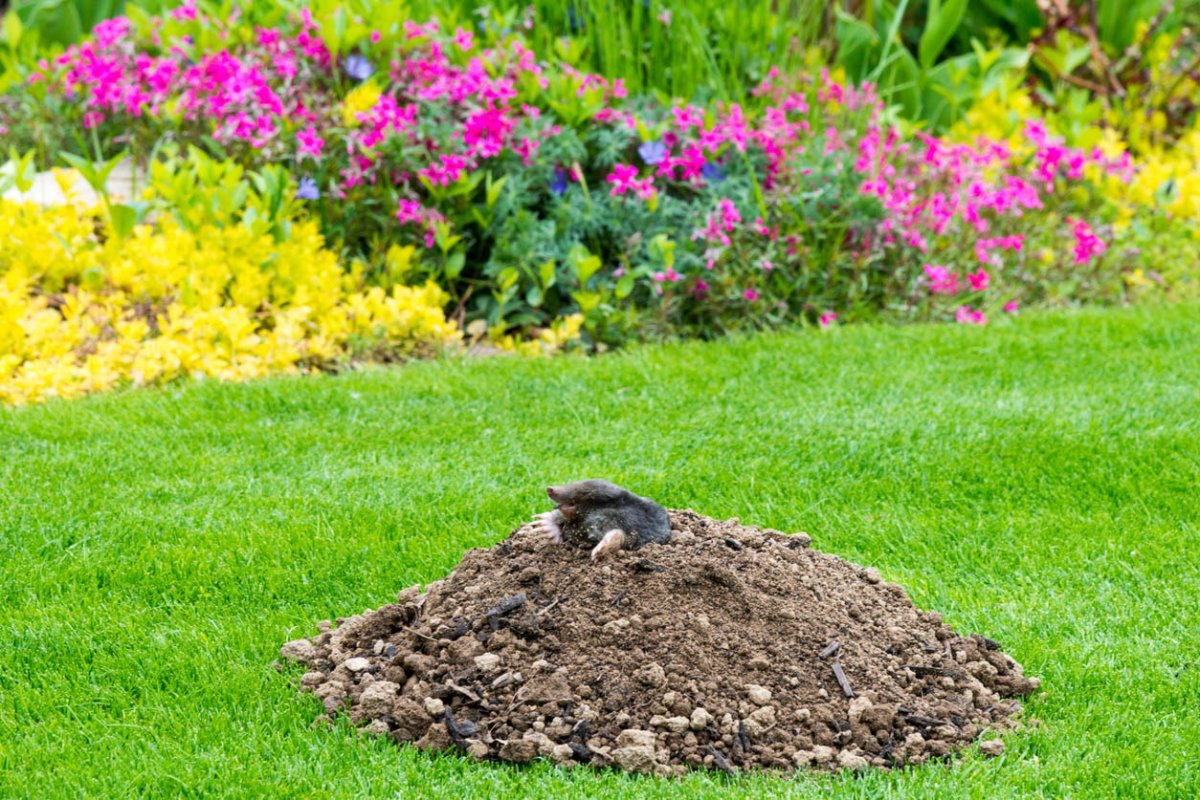We may earn revenue from the products available on this page and participate in affiliate programs. Learn More ›
Q: I keep finding mysterious holes all over my lawn. How do I determine what type of animal is digging holes in my yard?
A: There are many different animals that could be digging in a homeowner’s garden or leaving holes in the grass. When determining what makes small holes in the ground, there are a few factors for homeowners to consider, such as the size of holes in the grass and the presence of any mounds of dirt. Looking at pictures of animal holes in the yard can be useful for identification, but there may also be a distinctive smell or type of mess specific to a particular kind of animal. Those wondering, “What is making holes in my yard?” can find some possible answers in this guide. And for those who are uncertain about how to treat their nuisance wildlife problem, a wildlife removal or pest control service can solve this mystery and help keep critters out of the yard and garden.
Skunks dig in lawns to find insect larvae, and you may notice their distinctive smell.

There are two types of skunk holes: larger burrows for sleeping (typically around 8 inches wide and relatively deep) and little holes for finding food.
Skunks typically dig burrow entrances in the wild under objects like logs or large rocks. But a homeowner can also find skunk burrows under a home’s foundation, patio, or other outdoor structure. Feeding holes are small and shallow, typically only a few inches in diameter. Skunks create them to find insect larvae, their primary food source. These holes usually pop up in groups, not individually. According to the Iowa State University Extension, skunks may neatly roll up sod to make their feeding holes.
In addition to holes in the lawn, homeowners may be able to identify if a skunk is present by its distinctive and pungent odor. However, the glands skunks use to spray their smelly liquid take about 10 to 14 days to refill, so a homeowner may notice the holes before noticing a skunk’s smell. It may be possible to get rid of a skunk problem by installing a fence or motion sensor lights. Putting out some of the best skunk repellents, or natural alternatives such as jalapeno and cayenne, can also be effective. Those who would prefer to leave this task to a professional can expect to pay average skunk removal costs between $300 and $600.
Groundhogs, voles, and gophers burrow for shelter.
When wondering what animal digs holes in the yard, homeowners may discover that groundhogs, voles, or gophers might be the culprits.
Groundhog holes are medium-size holes or burrows that lead to an underground network. Typically, there’s only one entrance to these burrows, and they’re usually around 12 inches wide and near trees, walls, or fences. Homeowners can look into how to plug groundhog holes to get rid of groundhogs—filling the hole with soil or gravel typically does the trick. Otherwise, it might be worth the cost of groundhog removal to have the problem dealt with professionally.
Voles create even smaller, dime-size holes. If a homeowner sees small holes in the yard with no mounds, they may have been created by voles. Voles also make “runways” in the grass. These runways look like dirt-covered trails across a yard. Homeowners can expect to find vole runways and holes in the spring after snow and ice have melted. Emory Matts, a board-certified entomologist and technical service manager for Rentokil Terminix, explains that vole holes in the yard are often easily repaired. He goes on to say that “some years may have very high vole populations and with more voles, they can potentially do much more damage to the grass.” In this case, it’s a good idea for a homeowner to look into the best vole repellents or opt for professional vole removal.
Many homeowners have trouble telling the difference between gophers vs. groundhogs. Gophers leave behind more of a mess than groundhogs and voles, tearing up grass and uprooting plants. They might also chew up electric wiring or destroy sprinkler systems. To identify gopher holes, homeowners can look for mounds of dirt next to small burrows, usually about 2 to 3 inches wide. Some homeowners attempt to get rid of gophers by flooding or fumigating their holes. However, these methods can be limited in their effectiveness, so it’s typically best for a homeowner to hire a wildlife removal professional instead.
Moles create volcano-shaped mounds of dirt when digging, and they can wreak havoc on a yard.
Moles are ground-dwelling creatures that typically favor rich soil. Moles are sometimes mistaken for voles; however, the biggest difference between the holes made by voles vs. moles is that moles leave volcano-shaped mounds of dirt, whereas voles do not. Mole holes in the yard will look like raised tunnels with lumps of dirt or hills nearby and are especially likely to be found in a garden. Moles also tend to destroy the roots of plants and can damage a building’s foundation. Another sign of moles is an increase in weeds. A significant invasion of moles might indicate the presence of other soil pests.
Moles can wreak havoc on a yard in many ways, so identifying them early is crucial. A wildlife removal specialist can get rid of moles humanely while ensuring these critters don’t take over the property. The cost of yard mole removal starts at around $100.

Raccoons can make a mess of a yard and may pull out pieces of grass or sod.
It’s common to find raccoons digging through garbage cans or getting into food that might be left outside. However, homeowners may also find raccoon holes in the yard from where these critters have pulled out pieces of grass or sod and dug up the lawn or garden. Because they feed on grubs, raccoons tend to use their paws to pull and flip pieces of sod or rip and tear up grass with shallow roots. One way to identify raccoon activity is by their droppings. Raccoon poop looks like a dark tube that is a few inches long—if a homeowner notices this in addition to holes, it’s likely a raccoon is feasting on grubs in their lawn..
Additionally, skunks and raccoons often feed in the same area overnight. If there is a strong skunk smell in the yard, there might be a raccoon present as well.
Digger bees, earthworms, and wasps can also create holes in a yard.
Often, homeowners will assume only pests like groundhogs or moles can create holes in a yard, but insects and worms can be the cause, too.
Digger bees live underground, so they create tunnels in the soil, typically where the grass is sparse, to get to their nests. Homeowners may find digger bee holes in the early spring. On the other hand, wasps create nests in various places, from under the ground to inside tree hollows. Wasps are typically more dangerous than digger bees, as they’re aggressive, and their nests can hold up to 6,000 wasps. For this reason, it may be best to let one of the best pest control companies (such as Orkin or Terminix) investigate ground wasp holes in the yard.
Earthworms can also disturb the soil, especially if they’re plentiful. They, too, leave behind mounds or clumps of soil in a homeowner’s lawn or garden. Lots of small holes in the lawn are often indicative of earthworms rather than a larger mammal.
Chipmunks dig small, round holes to make burrows for shelter.
It’s not uncommon in many parts of the country to see chipmunks darting across a backyard or up a tree. However, not everyone is aware that these animals also like to burrow underground. Chipmunk holes are about the size of a golf ball, and chipmunks used them to nest in and look for plants and insects to eat. Homeowners may notice evidence of chipmunk in the form of discarded nut shells and fruits throughout the yard. Gardeners are often especially eager to get rid of chipmunks, as these animals like to snack on freshly planted bulbs and seeds. If this is the issue, placing commercial repellents around the perimeter of the yard can help mitigate the problem.
Although snakes can’t dig holes, they can make use of vacated holes dug by other critters.
Without arms or claws, snakes are not capable of burrowing in the same way as other animals. However, it’s still possible to have snake holes in the yard. Snakes will commonly take over holes created by voles, chipmunks, or other small animals for protection. There are a few ways to tell if snakes are inhabiting a yard. One is to look for shed skin or feces. Snake feces look like a dark smear that is white at the end. Another option is to set up a camera near the hole and watch for activity. Snakes are most active in the morning and afternoon when they can warm themselves in the sun. While many homeowners don’t relish the idea of having snakes in their yard, many varieties are nonvenomous and will not do significant damage. According to Thomas Ward, a training specialist and biologist at Critter Control, “Generally speaking, there is a fear of snakes across the board—if you’re not comfortable or proficient with snakes, don’t mess with them. Snakes, like a lot of wild animals, want to be left alone just like we want to be left alone.”
Rabbits dig holes to make burrows, though the holes are typically hidden and harder to spot.
Holes that appear in more secluded parts of the yard may be home to rabbits. Rabbits prefer to nest out of sight to keep out of reach of predators, and once they establish a home, they’ll continue to feast on nearby plants for as long as they can. Homeowners who have flowers, vegetables, or lawns that they’d like to protect will want to get rid of rabbits by eliminating rabbit holes in the yard and implementing some deterrents to keep them away for good.
Armadillos create long burrows that can cause major damage to a yard. They also dig to find insects, which make up the bulk of their diet.
While they aren’t present in all parts of the United States, armadillos have been moving north in recent years, and more and more homeowners are finding evidence of these animals in their yards. These unusual-looking creatures have scaly shells, pointed snouts, and long tails. They also have sharp claws that make them proficient diggers. Homeowners may not see these creatures in person since they are nocturnal, but armadillo holes in the yard are usually unmistakable. Armadillos’ burrows can reach a length of up to 15 feet and can cause significant damage to lawns and structures such as foundations. When they aren’t burrowing, armadillos also dig shallow holes to look for insects, which make up the bulk of their diet. Armadillos are not typically aggressive by nature, but due to their sharp claws and teeth, it’s recommended that homeowners leave getting rid of armadillos to a wildlife removal professional.
There are several measures you can take to stop animals from digging holes in your yard.
Animal holes in the yard can be an annoyance, but fortunately, there are a few ways to combat this issue. For one, it’s a good idea to eliminate whatever is attracting animals to the yard in the first place. This may include removing potential food sources such as fallen fruit or nuts and trimming overgrown bushes where critters are taking shelter. If animals are getting into planters or gardens, it can be useful to add barriers like wiring or fencing to keep animals out. Finally, there are a variety of natural and commercial deterrents that are effective at keeping most nuisance wildlife at bay. Some of the most common options that many homeowners already have on hand are cayenne, coffee grounds, castor oil, and mint.
If DIY measures are not sufficient, one of the best wildlife removal services, such as Critter Control or Trutech, will be able to help. Professional wildlife removal costs about $189 to $573 on average, but this cost may be well worth it to take back control of the yard and prevent future damage.
According to Ward, even if homeowners aren’t able to identify what animal is digging holes in the yard, a wildlife removal specialist will have no trouble getting to the root of the problem. “Often customers have no idea [what animal is in their yard]. They have either been hearing noises or seeing holes in the yard, and they don’t have any way of knowing … we do use your information to make that assessment, but in addition to that, we look for that evidence on our own and take those clues and consolidate them to figure out what animal we may be dealing with.”


